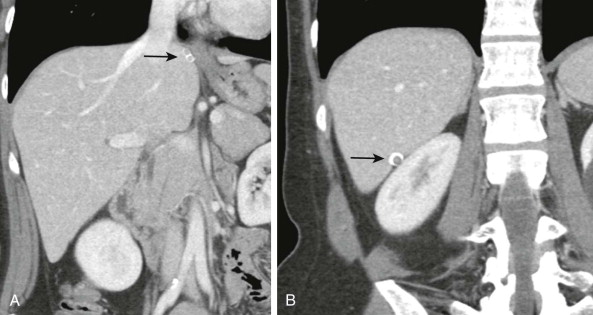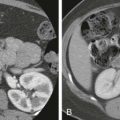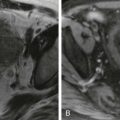Chapter Outline
Technical Considerations of Laparoscopic Cholecystectomy
Normal Imaging Findings after Uncomplicated Laparoscopic Cholecystectomy
General Postsurgical Complications
Post-Traumatic Lesions of the Biliary Tree
The two most common surgical procedures of the biliary tract likely to be encountered in day-to-day practice are laparoscopic cholecystectomy (LC) and biliary-enteric anastomosis. Specifically, given the high prevalence of cholelithiasis or gallstones in the United States, with roughly 20 to 25 million people affected, a large number of patients undergo cholecystectomy each year (~700,000). The revolutionary development and refinement of laparoscopic techniques during the last two decades have allowed LC to largely supplant open surgery. The creation of a biliary-enteric anastomosis (most often hepaticojejunostomy), on the other hand, can be performed for any number of different indications, the most common of which include liver transplantation, resection of tumors involving the biliary tree, benign or malignant biliary obstruction, biliary stones, and bile duct injuries.
Whereas LC and hepaticojejunostomy are both relatively well tolerated procedures with a low risk of complications, the large number of these procedures performed in the United States each year makes it critical for radiologists to recognize the different complications that may be associated with these surgical procedures and to understand the basic diagnostic and treatment algorithms for each of these complications. This chapter discusses a number of complications associated with LC and hepaticojejunostomy and illustrates their appearances by a number of different radiologic modalities. In addition, this chapter concludes with a discussion of the radiologic diagnosis of post-traumatic lesions of the biliary tree. These traumatic injuries to the bile ducts and gallbladder are relatively rare but can carry a high morbidity and mortality in cases of missed or delayed diagnosis.
Laparoscopic Cholecystectomy
Technical Considerations of Laparoscopic Cholecystectomy
The most common indication for LC is symptomatic cholelithiasis, although the procedure is also commonly performed for acalculous cholecystitis, large gallbladder polyps, gallbladder dyskinesia, gallbladder malignant neoplasms, and trauma. Contraindications to the procedure are uncommon but typically relate to an inability to tolerate general anesthesia, intractable bleeding disorders, or end-stage liver disease or cirrhosis.
Traditionally, LC has been performed with four incisions (four-port LC; Fig. 81-1A ). A 1-cm incision is made adjacent to the umbilicus, and a blunt trocar is inserted into the abdominal cavity, with the subsequent establishment of pneumoperitoneum (10-12 mm Hg) by the insufflation of carbon dioxide through a Veress needle. After the establishment of pneumoperitoneum, a laparoscope is inserted through this first incision. Next, three additional smaller incisions are made in the right lateral upper abdomen and to the left of the falciform ligament, and three trocars are inserted through these sites ( Fig. 81-1B ). Specialized grasping instruments are then inserted through these trocars to grasp the fundus and infundibulum of the gallbladder, to expose the surgical field, to dissect and clip the cystic artery and duct (with placement of a surgical clip), to remove the gallbladder through the periumbilical port, and to coagulate the gallbladder fossa ( Fig. 81-1C, D ).
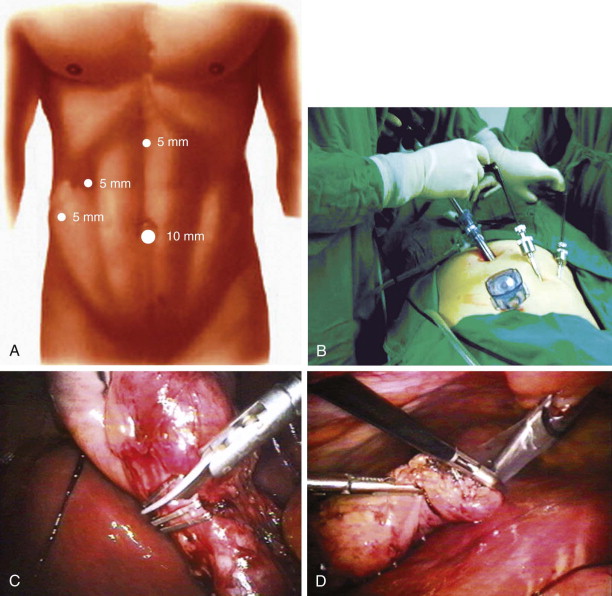
Increasingly, however, as a result of patient cosmetic concerns and a desire to reduce operative trauma to the abdominal wall, there has been a trend toward the use of fewer incisions and ports. The newest operative technique, known as single-port laparoscopic surgery, entails the creation of a single periumbilical incision, with the subsequent use of a specialized single port that contains four openings: one for gas insufflation and three for trocars to perform the surgical procedure. Whereas data on these new single-port techniques are still forthcoming, early studies have suggested improved cosmesis and decreased postoperative pain.
Normal Imaging Findings after Uncomplicated Laparoscopic Cholecystectomy
In most cases, the imaging findings after LC should be relatively minimal.
- •
A small amount of pneumoperitoneum is an expected finding. The volume of free air after laparoscopic procedures is generally smaller and lasts for a shorter time compared with open surgery, largely as a result of the relatively small incisions in the anterior abdominal wall and the use of carbon dioxide for insufflation (which is rapidly absorbed). As with other abdominal surgeries, the presence of a large amount of pneumoperitoneum after surgery, or pneumoperitoneum that persists for a longer than expected duration (10-14 days), should raise concern for bowel injury or perforation during the procedure.
- •
A small amount of subcutaneous emphysema at the incision site is not uncommon, usually resulting from the dissection of insufflated carbon dioxide around the trocars into the subcutaneous soft tissues. This finding is common in the first 24 to 48 hours after surgery but should not be seen in significant amounts thereafter.
- •
Small densities in the subcutaneous fat surrounding the trocar insertion sites can develop over time and probably represent sites of fat necrosis or scarring related to the surgical intervention.
- •
Small postoperative fluid collections in the gallbladder fossa are a common finding immediately after surgery and may be associated with a tiny amount of free fluid in the pelvis. These fluid collections are almost always asymptomatic and should resolve spontaneously. Nevertheless, if there are clinical signs of infection, reimaging may be helpful as these collections can rarely become superinfected and develop into abscesses.
- •
Permanent surgical materials, such as surgical clips, are a common finding in the gallbladder fossa. Potentially confusing, however, is the presence of absorbable hemostatic sponges, occasionally used intraoperatively to control bleeding, which should gradually be absorbed over time. The most commonly used of these materials is gelatin sponge (Gelfoam; Pharmacia and Upjohn, Kalamazoo, Mich) or oxidized absorbable cellulose (Surgicel; Ethicon, Somerville, NJ). The appearance of these absorbable agents on computed tomography (CT) is typically as a discrete mass with mixed or low attenuation and with central or peripheral gas collections ( Fig. 81-2 ). In the absence of a reliable clinical history, such an appearance can be extremely difficult to distinguish from a postoperative abscess or fluid collection, and a discussion with the surgeon may be necessary to arrive at the correct diagnosis. If not, this absorbable material should disappear in a period of weeks on serial CT examinations.
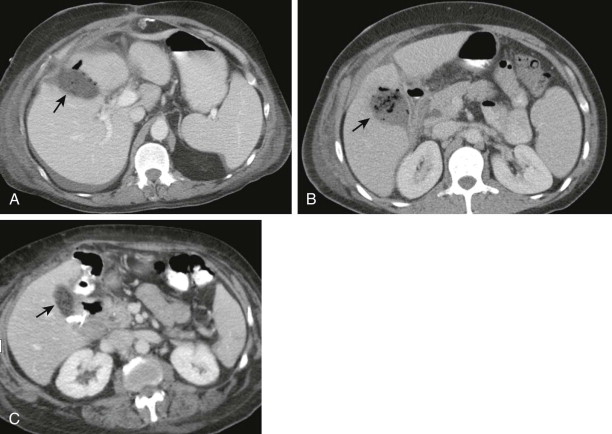
Figure 81-2
Hemostatic agents (Gelfoam or Surgicel) in gallbladder fossa in three different patients.
A to C. CT several days after LC in three different patients shows a low-attenuation, oval, masslike lesion in the gallbladder fossa with focal gas bubbles but no air-fluid level ( arrow ). This typical appearance of hemostatic agents should not be confused with abscess.
General Postsurgical Complications
Postsurgical complications after LC are relatively rare. Overall, there is no evidence in the literature that the transition from open to laparoscopic surgical technique has resulted in any appreciable increases in morbidity or mortality. A Cochrane Database review that examined 38 different studies in the literature (with 2338 patients) found no difference in mortality between open cholecystectomy and LC, and although there was the suggestion of a lower overall complication rate with laparoscopic technique, this could not be validated in the highest quality studies. Moreover, laparoscopic technique is clearly associated with a shorter hospital stay, better cosmetic results, less postoperative pain, and faster return to work.
Nevertheless, postsurgical complications are not infrequently encountered regardless of the surgical technique used. Complications are thought to be more likely in patients with active (or prior bouts of) cholecystitis, longer time (typically > 72 hours) between the onset of cholecystitis symptoms and surgery, male gender, prior upper abdominal surgery, significant pericholecystic fluid, high body mass index, diabetes, and advanced age, all of which are factors that may render LC more technically difficult. Notably, these same patient factors represent the most common risk factors for conversion of LC into an open procedure, and the conversion rate is thought to be as high as 12%. As one would expect, patients with significant gallbladder inflammation (including gangrenous and emphysematous cholecystitis) are also at higher risk for complications and conversion to an open procedure.
Complications of LC include those associated with the laparoscopic component of the procedure as well as those related to the cholecystectomy itself. The most common complications related to laparoscopy include abdominal wall or omental bleeding, intraperitoneal or retroperitoneal vessel injury, bowel injury or perforation, and solid visceral organ injury. The most common complications related to cholecystectomy include gallbladder fossa bleeding, bile duct injury, bile leakage, gallbladder perforation (with stone spillage), retained biliary stones, and biliary strictures. Less commonly, laparoscopic cholecystectomies can be complicated by vascular injuries, with an incidence ranging between 0.05% and 0.25%. Vascular injury is the second leading cause of death in patients undergoing laparoscopic procedures (of any kind), and the hepatic artery is the most frequently injured vessel during LC. Given that the mortality rate for patients suffering vascular injuries during laparoscopy can be as high as 9%, careful evaluation of the hepatic artery along its entire course is critically important in evaluating multidetector CT (MDCT) studies in patients who have recently undergone LC.
The majority of complications are manifested in the early postoperative period, but others may appear weeks or even months after the procedure. Most patients undergoing LC experience an uneventful, straightforward postoperative course, but a high index of suspicion is essential for those patients who demonstrate any concerning symptoms, including fevers, persistent abdominal pain, tachycardia, vomiting, or high degrees of bile output from a drain or wound site.
Biliary Tract Complications
Biliary tract complications are the most important complications of cholecystectomy and represent a major source of litigation. Biliary tract complications can be encountered with both open and laparoscopic cholecystectomies, and there is little evidence of any increase in biliary tract complications with laparoscopic technique. Many of these complications are often not recognized at the time of surgery and are not uncommonly diagnosed after a significant delay, resulting in considerable patient morbidity and mortality. The most important biliary complications for the radiologist to recognize are bile duct injury, bile leak, retained stones, bile duct strictures, and spilled stones in the peritoneal cavity.
Bile Duct Injury and Bile Leak
There are more than 2500 bile duct injuries related to LC in the United States each year, and many of these injuries are attributable to acute or chronic inflammation obscuring fat planes surrounding the gallbladder or intraoperative misidentification of the common bile duct (CBD) by the surgeon. Other risk factors include inadequate exposure, patient obesity, congenital anatomic anomalies of the bile ducts, emergent surgery, and failed cholangiography. The incidence of bile duct injury after LC is 0.1% to 1.3%, and although there does not appear to be a significant difference in the incidence of bile duct injuries compared with open procedures, injuries after LC may possibly be more severe.
Bile duct injuries encompass a wide range of different lesions, including tears, transections, and ligations. The most common injury results in a defect of the CBD due to a portion of the CBD having been mistaken for the cystic duct and, as a result, being partially or completely transected. Many minor bile duct injuries (perhaps seen in up to 1.2% of patients) are now successfully treated with endoscopic management (usually internal drainage), allowing bile flow away from the site of injury into the duodenum and consequently allowing the injured bile duct segment to heal. On the other hand, complex or severe bile duct injuries (i.e., common hepatic duct, CBD, right hepatic duct, or transection of the right posterior sectoral duct) are almost always treated with surgical biliary reconstruction.
There is debate within the surgical literature as to whether the routine use of intraoperative cholangiography (IOC) can help reduce the incidence of bile duct injury, and some surgeons advocate that cholangiography should constitute a routine component of every LC. Proponents argue that IOC can help better define biliary anatomy, thereby reducing the incidence of biliary injuries. Moreover, in those cases in which injuries occur, proponents argue that IOC allows earlier discovery of these injuries. However, those who argue against routine cholangiography suggest that instead of reducing the incidence of bile duct injury, surgeons performing IOC may actually cause a bile duct injury while attempting to cannulate the cystic duct or by inadvertently cannulating the CBD. Moreover, IOC undoubtedly increases operative time and surgical costs.
Depending on its severity, bile duct injury can result in a frank bile leak ( Figs. 81-3 to 81-9 ). Whereas bile leaks can theoretically occur at any site of bile duct injury, the most common locations are the cystic duct stump, the duct of Luschka, and the gallbladder bed. When leaks occur at the cystic duct stump (the most common site of bile leak), causes can include a misplaced surgical clip, resulting in inadequate closure of the cystic duct; necrosis of the cystic duct after placement of a clip; elevated CBD pressures (often due to a distally impacted CBD stone) transmitted to the cystic duct, resulting in cystic duct “blow-out”; and operative injury to the cystic duct. In those cases attributable to operative injury, leaks may occur because of difficulty in dissecting the cystic duct and common hepatic duct, particularly when adhesions are present, and as a result of unrecognized aberrant ducts. The second most common site of bile leak is from the duct of Luschka, an accessory duct in the right hepatic lobe that traverses the gallbladder fossa and can drain into either the right or common hepatic duct. This bile duct is uniquely vulnerable to injury and leak as a result of its variable course and location within the operative field.
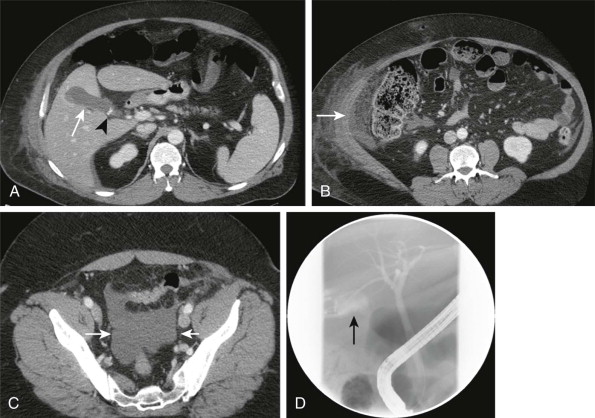
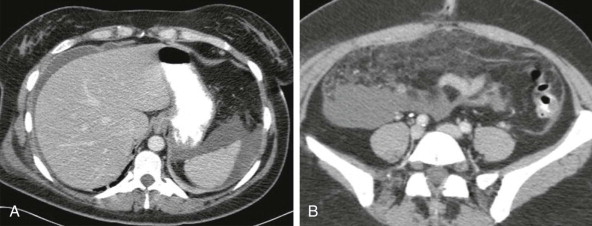
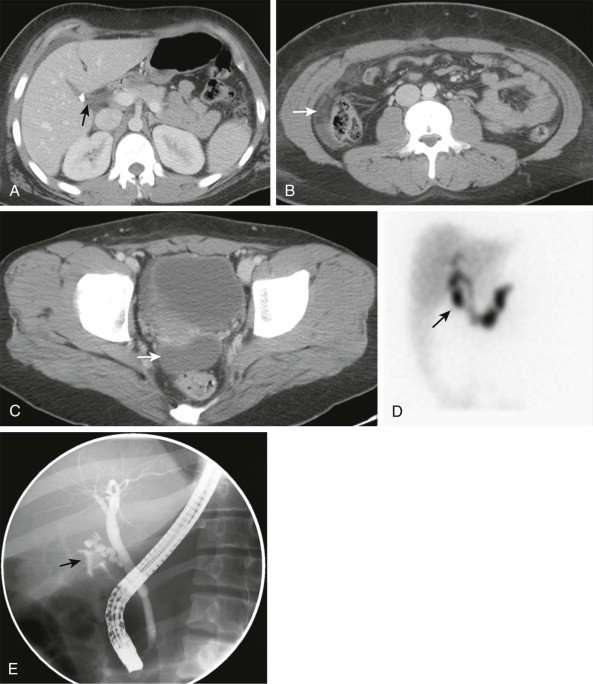
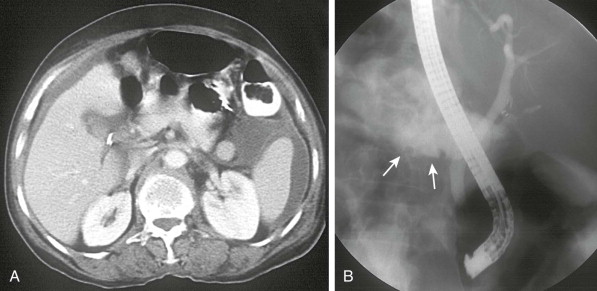
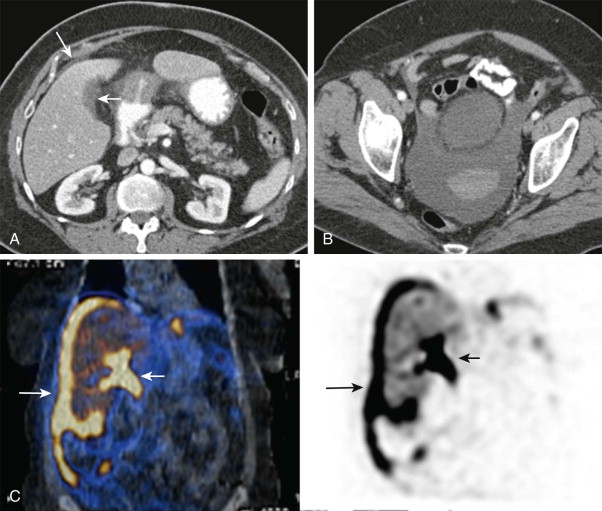
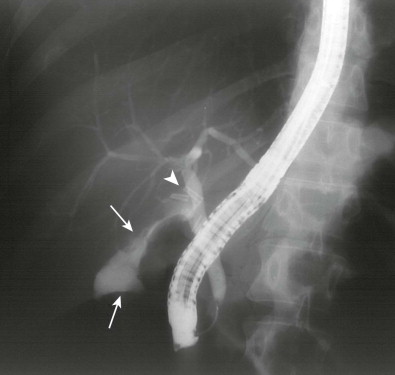
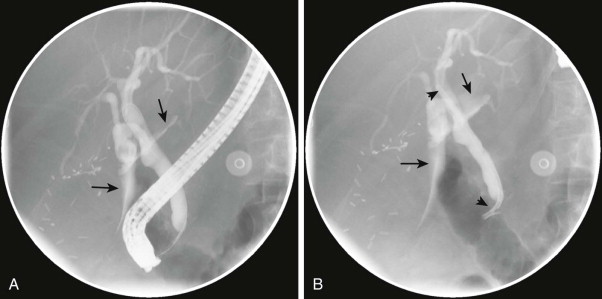
Bile leaks carry a high risk of morbidity and mortality and should be suspected in any patient who presents with fever, jaundice, abdominal pain, peritonitis, or elevated liver function test results in the first week after surgery. In particular, a markedly elevated serum bilirubin level and, alternatively, the presence of significant bile output from an abdominal drain are both features highly suggestive of a large biloma, although the absence of bile output from an abdominal drain cannot exclude a bile leak. Bile can leak freely into the peritoneal cavity, resulting in either sterile or infected biliary ascites (see Figs. 81-3 to 81-7 and 81-9 ), or accumulate into a loculated fluid collection, resulting in a sterile biloma (see Figs. 81-3A and 81-8 ) or an infected abscess ( Fig. 81-10 ).
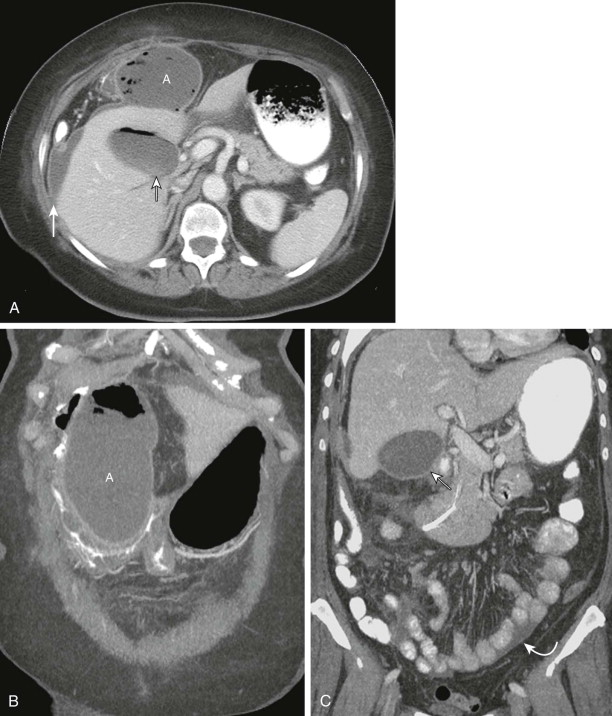
The treatment of bile duct injuries and leaks remains controversial, and there are a number of different management algorithms in use. In general, patients with a suspected bile leak and a single fluid collection or biloma on CT are initially treated with placement of a percutaneous drainage catheter. Although it is uncommon, in a small subset of patients with a minor leak and minimal bile duct injury, there is the possibility of spontaneous resolution of the leak after placement of the drainage catheter. If the leak then fails to resolve, patients typically proceed to endoscopic retrograde cholangiopancreatography (ERCP), in which minor leaks are treated with placement of a biliary stent. The biliary stent diverts bile away from the site of biliary injury into the duodenum, giving the injured segment time to heal (see Fig. 81-9B ). Notably, whereas sphincterotomy has traditionally been thought to be useful in these patients, there is now little consensus in the literature on its utility; some studies suggest that this procedure raises the risk of perforation, bleeding, and mortality, and there are few data to suggest that sphincterotomy provides benefit in terms of leak resolution. If a major bile leak or significant biliary injury is detected on ERCP, patients undergo operative repair and biliary reconstruction.
Retained Biliary Stones
Small biliary stones occasionally remain after LC, often within the intrahepatic or extrahepatic biliary tract. Moreover, in some cases in which LC is technically challenging as a result of difficulty in identifying anatomic landmarks, adhesions, marked bleeding, or severe gallbladder inflammation, portions of the gallbladder infundibulum may be inadvertently left behind (subtotal cholecystectomy), and this gallbladder remnant may contain stones. Such incomplete resection of the gallbladder is relatively common, occurring in up to 13.3% of cholecystectomies. For the same reasons, particularly in patients with an unusually long cystic duct, portions of the cystic duct containing stones may also be left behind after surgery.
These retained stones, regardless of whether they reside within the intrahepatic biliary tree, CBD, cystic duct stump, or gallbladder remnant, may subsequently migrate distally into the CBD, resulting in biliary obstruction ( Fig. 81-11 ). The overall incidence of retained stones, regardless of location, after LC is 0.5%; the most common location for retained stones is within the CBD, with an incidence ranging between 5% and 15%. There is some debate in the literature as to the necessity of defining the presence of biliary tract stones (outside the gallbladder) by preoperative magnetic resonance cholangiopancreatography (MRCP), and some surgeons advocate performing intraoperative cholangiography for the purpose of detecting biliary stones in the highest risk patients during cholecystectomy.
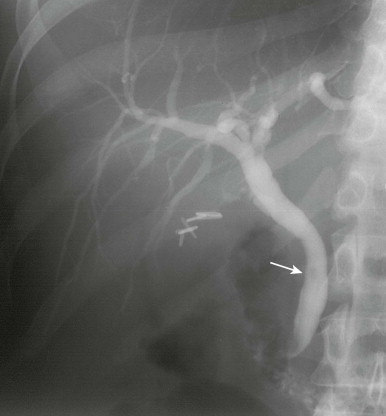
It is thought that retained stones in the biliary system after cholecystectomy may be a common cause for postcholecystectomy syndrome, a term used to describe the recurrent biliary colic symptoms suffered by 10% to 40% of patients after cholecystectomy. Symptoms of retained biliary stones can include jaundice and right upper quadrant pain, and the diagnosis is usually made in the first 2 months postoperatively. Rarely, retained distally impacted stones in the CBD may secondarily result in biliary leakage from the cystic duct remnant by causing increased biliary pressure that displaces the cystic duct clips, a phenomenon often referred to as cystic duct blow-out. Retained stones can usually be extracted by ERCP and sphincterotomy. Open or laparoscopic CBD exploration is only rarely necessary.
Bile Duct Strictures
Postoperative biliary strictures are not uncommon with both open and laparoscopic cholecystectomies. Several different causes have been proposed, including focal bile duct ischemia due to intraoperative damage and thermal injury during surgical dissection, intense connective tissue response with fibrosis and scarring as a result of bile duct manipulation, inadvertent clipping or ligation of the bile duct, and scarring as a result of T-tube placement ( Figs. 81-12 and 81-13 ).
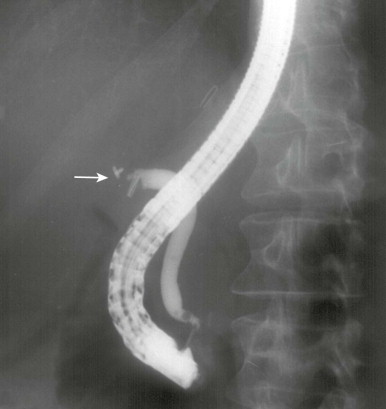
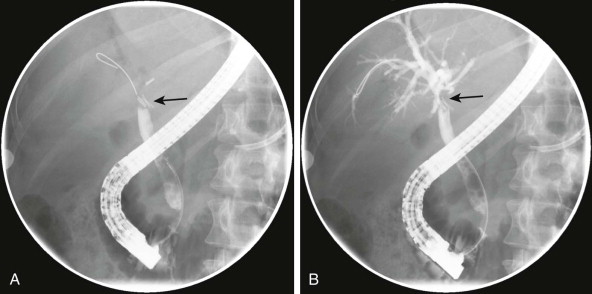
Biliary stricture after cholecystectomy is relatively rare, occurring in 0.2% to 0.5% of patients. In many cases, these strictures are not recognized for months or years after the patient’s surgery, with a mean time to stricture of 3 to 6 months. Many patients are not overtly symptomatic, and the diagnosis is often made on the basis of progressive biliary dilation on cross-sectional imaging. In other cases, patients can present with painless jaundice, cholangitis, or sepsis. Patients with a markedly delayed diagnosis may ultimately present with advanced biliary cirrhosis and its complications.
Whereas surgical treatment (usually in the form of a Roux-en-Y hepaticojejunostomy) has traditionally been the treatment of choice for iatrogenic biliary strictures related to LC, endoscopic treatment is increasingly becoming the first-line treatment of choice. In addition to being safer and better tolerated (with lesser degrees of associated morbidity and mortality), endoscopic balloon dilation with stent placement has been associated with a lesser risk of recurrent strictures and cholangitis, although patients may require multiple sessions of balloon dilation with periodic replacement of bile duct stents. In particular, endoscopic approaches appear to be more effective for strictures in the distal CBD, whereas surgery may still be the preferred option for complex strictures in the more proximal CBD.
Imaging of Postoperative Bile Duct Injuries
Ultrasound and Multidetector Computed Tomography.
In most patients with a suspected bile duct injury or leak after LC, ultrasound and contrast-enhanced CT are the most common initial imaging studies performed. Both studies can be completed quickly and efficiently, even in the most critically ill patients, and ultrasound can be performed at the bedside in the critical care setting. In most cases, both studies will demonstrate an intra-abdominal fluid collection, most often in the right upper quadrant (often the subhepatic space or gallbladder fossa) close to the surgical bed (see Figs. 81-1 and 81-3 to 81-7 ). CT, in particular, can better delineate peripheral enhancement and complexity and distinguish free bile fluid from a loculated biloma. Notably, however, neither imaging modality can distinguish a biloma from other common causes of a postoperative fluid collection, including a seroma, abscess, hematoma, or lymphocele; the distinction between these different entities is often based on the analysis of fluid obtained from surgical drains or the direct aspiration of a fluid collection under image guidance (CT or ultrasound). In addition, the location of a collection may not be helpful in distinguishing these entities; bile fluid can potentially disperse widely throughout the peritoneal cavity (see Figs. 81-1 and 81-3 to 81-7 ) and become loculated relatively distant to the site of bile leak, whereas lymphoceles, abscesses, seromas, and hematomas can develop in close contiguity with the biliary tree (i.e., gallbladder fossa or subhepatic space; see Fig. 81-10 ). In addition, neither ultrasound nor CT can accurately define the source of a leak, and cholangiography may be necessary to differentiate leaks originating from different sites in the biliary tree (see Figs. 81-3D, 81-5E, 81-6B, 81-8, and 81-9 ).
Both CT and ultrasound are also important tools in identifying evidence of biliary dilation, often before there is biochemical evidence of obstruction. New biliary dilation after a cholecystectomy should suggest either the presence of a retained CBD stone (with associated obstruction) or, alternatively, the development of a bile duct stricture. At the same time, a mild degree of biliary dilation after cholecystectomy is a normal finding and should not be overinterpreted as obstruction. Although the presence of bowel gas will often obscure the distal CBD and ampulla (perhaps in a majority of cases), in certain rare cases, ultrasound may be able to define a distal CBD stone as a highly echogenic focus with posterior acoustic shadowing. Alternatively, although the diagnosis can be difficult on CT, the use of multiplanar reformations and three-dimensional reconstructions can help define the course of the CBD along its entire length and may demonstrate a meniscus sign at the site of obstruction by a CBD stone. Depending on the calcium content of a stone, an obstructing retained stone may be radiodense and calcified or of soft tissue attenuation. Whereas bile duct injury or stricture is the other diagnostic possibility when one is confronted with progressive dilation of the biliary tree after cholecystectomy, the absence of bile duct dilation on CT or ultrasound does not exclude bile duct injury, and further investigations will often be necessary if these entities are strongly suspected clinically.
Hepatobiliary Scintigraphy.
Hepatobiliary scintigraphy, most often performed with technetium Tc 99m mebrofenin (or a number of other technetium-based agents) has proved to be an extremely sensitive method for detecting both bile leaks and biliary obstruction (see Figs. 81-5D and 81-7C ). In particular, hepatobiliary scintigraphy has proved to be extremely accurate in identifying bile leaks in the setting of a recent cholecystectomy, with a sensitivity that may approach 100%, even including leaks into diagnostically difficult locations, such as the lesser sac. Not only can the extravasation of radiotracer from the biliary system during scintigraphy reliably identify the presence of a leak, the absence of a leak can allow the clinician to confidently proceed with conservative management.
Nevertheless, hepatobiliary scintigraphy has certain key limitations, which can diminish its utility. Most important, whereas scintigraphy can identify the presence of leak, it cannot accurately delineate the site of leak, limiting its ability to guide further intervention. Moreover, although the modality can identify the leak, it provides no information about the severity of the leak or bile duct injury, again somewhat limiting its usefulness in terms of guiding subsequent therapy and intervention. For example, scintigraphy cannot differentiate between the complete transection of a duct (which would typically require surgery) and a minimal tear of a duct (which could potentially be treated endoscopically).
Percutaneous Transhepatic Cholangiography.
Whereas evaluation of the biliary system after a suspected bile duct injury almost always begins with ERCP, this modality struggles in certain situations; specifically, in performing ERCP, occlusion or transection of a large central bile duct is visualized as only a “stump” of the CBD, and the more proximal biliary tract cannot be visualized. This is of critical importance as the more proximal biliary tract must be visualized to facilitate surgical planning as well as to evaluate for other sites of potential bile duct injury. Moreover, injuries to the right posterior segmental bile duct draining segments VI and VII will often be missed on ERCP, and this is a commonly underdiagnosed and underappreciated site of bile duct injury during cholecystectomy. As a result, percutaneous transhepatic cholangiography (PTC) is considered to be the “gold standard” radiographic examination in the evaluation of patients with suspected biliary injuries or strictures as it allows evaluation of the entire proximal biliary tree (even in cases with a significant distal bile duct injury) and the reliable identification of injuries to the right posterior segmental bile duct.
In most institutions, ERCP is typically performed first in the setting of a suspected bile duct injury to differentiate patients with a cystic duct leak or incomplete tear of a duct from those with a complete duct transection. Those patients with a completely transected duct then undergo PTC for evaluation of the proximal ductal system. In addition to its valuable diagnostic role, PTC also serves as the first step in the placement of a percutaneous transhepatic catheter, allowing decompression of the biliary system either to treat or to prevent cholangitis resulting from biliary obstruction. Moreover, PTC can also facilitate the percutaneous treatment of biliary strictures, usually with balloon dilation.
Endoscopic Retrograde Cholangiopancreatography.
ERCP is an excellent modality for both the diagnosis and management of many biliary complications after LC. In almost all cases, ERCP will be the first diagnostic study performed in the setting of a suspected leak, and in many cases, it may be the only required study.
With regard to biliary leaks, ERCP can identify the site of bile leak in more than 95% of cases, a clear advantage relative to other diagnostic studies, such as contrast-enhanced magnetic resonance imaging (MRI) and hepatobiliary scintigraphy, which cannot reliably identify the exact site of leakage (see Figs. 81-3D, 81-5E, 81-6B, 81-8, and 81-9 ). Compared with PTC, ERCP has a generally lower rate of complications and carries a lesser risk of iatrogenic bile duct injury, bile leak, cholangitis, and sepsis. ERCP is also a highly effective means of treating bile duct leaks as these complications can be managed endoscopically in more than 80% of cases (biliary stents with or without sphincterotomy). Nevertheless, ERCP is an invasive modality with an associated risk of postprocedural complications and the need for patient sedation.
Whereas ERCP alone is sufficient in the diagnosis of low-grade strictures and injuries to the major central bile ducts, it is insufficient in patients with complete obstruction of the extrahepatic biliary tree or with high ductal injuries as the intrahepatic bile ducts more proximally cannot be visualized. In these cases, PTC is needed to evaluate the intrahepatic ducts and to fully define the exact length of a patient’s stricture. When both studies are performed, a gap of several centimeters may be present between a blind-ending distal duct demonstrated on ERCP and the proximal bile ducts opacified on PTC, precluding percutaneous transhepatic stricture dilation. As mentioned previously, the treatment for bile duct strictures is gradually moving away from surgical reconstruction and toward endoscopic management (usually balloon dilation and stenting; see Fig. 81-9 ), although surgery continues to play a major role in certain lesions.
Magnetic Resonance Cholangiopancreatography.
During the last several years, the introduction of a number of different hepatobiliary contrast agents for MRI, the most important of which is gadoxetate disodium (Eovist; Bayer HealthCare Pharmaceuticals), has made MRI a highly valuable option for the detection of bile leaks. These agents, which are excreted into the biliary system in varying amounts, allow the acquisition of normal contrast-enhanced images in the arterial, venous, and delayed phases, followed by excellent opacification of the biliary system in the delayed hepatobiliary phase (usually at 10 to 20 minutes). This opacification of the biliary system has been improved with the introduction of gadoxetate disodium, 50% of which is excreted through the hepatobiliary system, compared with 3% to 5% of older hepatobiliary contrast agents, allowing faster and more avid enhancement of the bile ducts. A number of studies, conducted with a variety of different hepatobiliary agents, have suggested that contrast-enhanced MRI does very well in the identification of bile leaks, with a sensitivity up to 95% and a specificity up to 100%. Bile leaks on these images appear as areas of active extravasation of contrast material from the involved segment of the biliary tree into the peritoneum and perihepatic space. In the more chronic setting, contrast-enhanced MRI with hepatobiliary agents can also be potentially helpful in terms of identifying sites of biliary narrowing or obstruction as a result of biliary strictures. Although it is not completely necessary, conventional MRCP images (highly T2 weighted volumetric images) may be helpful as an ancillary imaging sequence to identify obstructing stones as well as to provide high-resolution volumetric images of the biliary tree to identify subtle sites of stricture or narrowing.
However, the use of these agents is limited in patients with cirrhosis, jaundice, or significant hepatobiliary disease as excretion of the contrast agent into the biliary system may be significantly impaired in such patients. This can be a significant obstacle to the use of this technique in patients with bile duct injury or bile leak after cholecystectomy as many of these patients present with hepatobiliary dysfunction and jaundice. Moreover, as with other MRI examinations, the quality of images depends heavily on the patient’s ability to adequately perform a breath-hold maneuver, a necessity that can be a problem in critically ill patients.
Spilled Gallstones
Whereas LC has proved extremely effective during the last two decades, largely obviating the need for open cholecystectomy except in the most complicated cases, the use of this technique has resulted in an increased incidence of “spilled,” “dropped,” or “retained” gallstones during the procedure. Spilled gallstones result from perforation of the gallbladder during cholecystectomy, with subsequent spillage of stones into the intraperitoneal space. Unlike in open cholecystectomy, in which these stones are relatively easy to identify and to retrieve during the course of the procedure itself, surgeons performing LC may not realize that stones have been spilled or alternatively may not have adequate surgical exposure to retrieve the stones laparoscopically. The incidence of gallbladder perforation during LC may be as high as 36%, and the rate of gallstone spillage may reach 19%. Moreover, when spillage occurs, one series found that up to 50% of stones were lost and not retrieved during the procedure. If spilled stones are noted intraoperatively, the surgeon will often attempt to retrieve as many stones as possible. Nevertheless, given the low rate of associated complications, most surgeons will not convert the procedure to an open cholecystectomy to retrieve every possible stone, and some stones will undoubtedly be left behind.
Whereas spilled gallstones are common, the incidence of complications related to these stones is relatively rare, occurring in 8.5% of patients. Most patients are asymptomatic, and in many cases, stones are simply discovered as an incidental finding on an imaging examination (usually CT or MRI) ( Figs. 81-14 to 81-16 ). Complications are thought to be more likely with infected stones (in the setting of acute cholecystitis), larger stone size (>1.5 cm), pigment stones, and increased age of the patient. The most common complication related to spilled stones is the development of an abscess surrounding the stones, either within the abdominal cavity (usually the subhepatic space or in the retroperitoneum inferior to the subhepatic space) or within the anterior abdominal wall itself ( Figs. 81-17 and 81-18 ). These abscesses can develop months or even years after surgery, and radiologists should always consider this a potential cause when confronted with a patient who develops an abdominal abscess of unknown etiology. The delay between cholecystectomy and abscess presentation can be considerable, probably as a result of the indolent nature of the inflammatory process and the often unusual sites of these abscesses. In one review, the time interval between cholecystectomy and the onset of symptoms was 5.5 months (range, 0-36 months).

